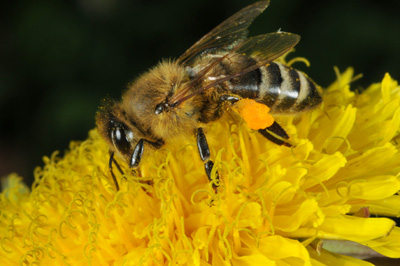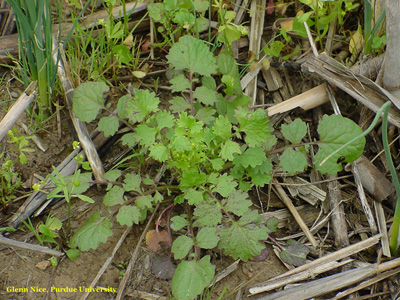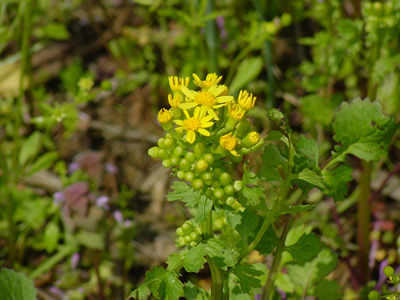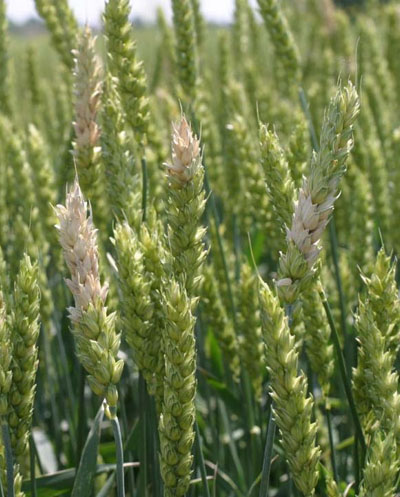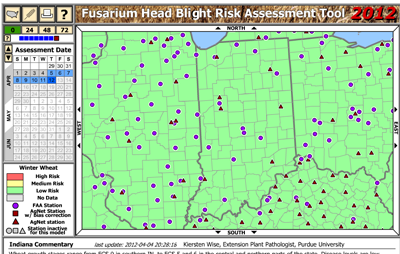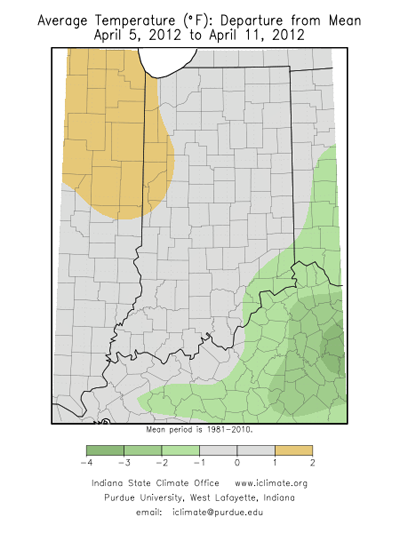Pest & Crop Newsletter, Entomology Extension, Purdue University
- Protecting Honey Bees During Field Crop Planting Season
- Did Black Cutworm and Weevils Freeze With Recent Low Temperatures?
- Black Cutworm Adult Pheromone Trap Report
- Rust Diseases Present in Indiana Wheat
- Tools Available to Monitor Risk of Fusarium Head Blight (Scab) in Indiana Wheat
Protecting Honey Bees During Field Crop Planting Season- (Christian Krupke)
Field crops planting season is underway in the Midwest. Although our field crops don’t need pollinators to form a crop, they are important for most fruits and vegetables we eat. There has been a great deal of media attention on pollinator decline in general, and the plight of honey bees in particular. Insecticides, specifically neonicotinoids (e.g. Cruiser, Poncho), have received research attention in search of the cause of these die-offs.
That’s where field crops come in - most of the annual crop acreage planted in North America this year will use neonicotinoid treated seed, close to 200 million acres total and over 90 million in corn alone. Neonicotinoids are a family of insecticides that are extremely toxic to honey bees, and recent research has suggested that honey bees that forage near these types of plantings may be at risk. The risk may be greatest during the period while crops are being planted. Dr. Christian Krupke and Dr. Greg Hunt (Purdue Extension Entomology) presented an overview of the current research at Purdue and elsewhere and offered suggestions for both field crop growers and beekeepers that can minimize the chances of honey bee exposure to these chemicals in the field. The recorded version of the webinar is available at the link below: <https://gomeet.itap.purdue.edu/p32228058/>
Close-up of a honey bee on a dandelion
![]()
Did Black Cutworm and Weevils Freeze With Recent Low Temperatures? – (John Obermeyer)
Last week’s articles were concerning the eye-popping numbers of black cutworm moths being captured by pheromone trap cooperators and weevil damage being reported in alfalfa. Did the low temperatures of April 11 and 12, likely devastating to Indiana’s fruit crop, freeze these pest insects? The short answer, probably not.
The black cutworm’s most vulnerable stage for freezing, the neonate (newly hatched) larvae, were likely nestled within the soil or under weeds in which they were feeding. Temperatures in these micro-environments are much warmer, especially with the radiant heat from the ground. Besides, it would take more than just a few hours of freezing temperatures to cause mortality. For alfalfa weevil, the early instar larvae are able to withstand temperatures as low as -2°F, much lower than that reached in any of the past couple nights. Though the top of the alfalfa looks terrible, the weevil larvae will move to unaffected areas of the plant to commence feeding. Happy Scouting!
![]()
Click here for the Black Cutworm Adult Pheromone Trap Report
![]()
Cressleaf Groundsel (Packera glabella) – (Travis Legleiter and Bill Johnson)
Cressleaf Groundsel is a winter annual weed that has been becoming more prevalent in Indiana pastures and agronomic crop ground over the past couple of years. The small seeds produced by this weed allow it to thrive in reduced and no-till systems as well as poorly established pastures. Cool and wet springs of the past couple of springs have also favored cressleaf groundsel, as it is a weed that prefers moist soils and typically struggles in hot and dry weather.
Much like most winter annual weeds, cressleaf groundsel emerges as a rosette in the fall then bolts, flowers, and produces seed in the spring. Basal rosette leaves are deep pinnate serrations with roundly lobed leaf margins. Leaves are typically 2 to 10 inches in length (Britton and Brown 1970). Bolting stems are hollow and can reach up to three feet in height with inflorescences that contain six to twelve yellow ray flowers that are often compared to the flowers of common dandelion. When looking for cressleaf groundsel in older weed id or taxonomic guides be aware that it has traditionally been placed in the Senecio genus and only recently was placed into the Packera genus.
The competitiveness of cressleaf groundsel with agronomic crops has not been researched, though its presence as a winter annual in no-till fields will have the same implications of slowing soil warming and drying as other winter annual weeds. The presence of this weed in pastures and hay fields should be of more concern as it does contain toxic properties when ingested by livestock. Leaves, flowers, and seeds of cressleaf groundsel contain alkaloids that will cause liver damage in livestock that is termed seneciosis and typically occurs on a chronic level (Kingsbury 1964). Symptoms of seneciosis are lose of appetite, sluggish depressed behavioral patterns, and in extreme cases aimless walking without regard to fences or structures. Although cressleaf groundsel is not as toxic as many of its relatives in the Packera genus, livestock producers encountering this weed in pastures or hay should take steps to avoid prolonged ingestion by animals.
Cressleaf grounsel rosette with deep pinnate serrations on basal leaves
Cressleaf groundsel inflorescence with yellow ray flowers and buds
Bolting cressleaf groundsel with flowering inflorescence
Herbicide applications to control of cressleaf groundsel are most effective when applied to plants in the rosette stage, bolting plants are very difficult to control with herbicides. Infestations in pastures can be controlled with 2,4-D or a combination of 2,4-D and dicamba applied to rosettes in the fall or early spring prior to bolting (Nice 2008). Producers should be aware that applications of these herbicides will also kill favorable broadleaves that are present in pastures.
Control recommendations for cressleaf groundsel in no-till agronomic crop fields has typically been to apply 2,4-D @ 1 qt/A to actively growing rosettes in the fall. Recent research at Illinois University (Lake and Hager 2009) has shown that fall or spring applications to 5-20 cm diameter rosettes with the following herbicides and rates can achieve 94% or greater control of cressleaf groundsel:
1 oz/A Canopy EX
1-2 qt/A glyphosate (4lb ai formulation)
1-2 qt/A glyphosate + 1-2 pt 2,4-D (4 lb ai formulation)
3 pt Extreme
In general the treatments applied in the fall resulted in greater biomass reduction of cress leaf groundsel, although all treatments and timings prevented plants from producing seed.
Reference:
Britton, N. and A. Brown. 1970. An Illustrated Flora of the Northern United States and Canada. Volume 3. Dover Pulbications, Inc., New York. Pp 540-544.
Kingsbury K.M. 1964. Poisonous Plants of the United States and Canada. Pentice-Hall, Inc., Englewood Cliffs, N.J. pp 425-435
Lake, J.T. and A.G. Hager. 2009. Herbicide Selection and Application Timing for Control of Cressleaf Groundsel (Packera glabella). Weed Technol. 23:221-224
Nice, G. 2008. Guide to Toxic Plants and Forages. Purdue Extension Pulbication WS-37
Rust Diseases Present in Indiana Wheat – (Kiersten Wise)
Stripe rust and leaf rust have been confirmed by crop consultants at low levels in several wheat fields in far southern IN, near Gibson County. Producers should be aware of these diseases and scout fields to determine if rusts are present, and at levels that may warrant fungicide application.
The diseases can be differentiated by the color and pattern of the pustules on the leaves. The fungus that causes stripe rust (Puccinia striformis) produces a yellowish or orange spore, and pustules appear in a row on infected leaves, giving it a “striped” appearance (Figure 1). Leaves infected by the fungus that causes leaf rust (Puccinia triticina) have brownish pustules that are scattered on the leaf (Figure 2). Purdue Extension Bulletin BP-79-W, “Identifying Rust Diseases of Wheat and Barley” is available to aid in diagnosis of these diseases, and can be found at the following link: <https://mdc.itap.purdue.edu/item.asp?itemID=19349>.
Both rust fungi prefer humid, wet weather and moderate temperatures to infect wheat and develop disease. However, the stripe rust fungus can infect under cooler conditions, which may be problematic in Indiana wheat fields with the recent weather. Each disease has the capacity to cause yield loss if infections occur prior to heading and environmental conditions favor disease development and spread.
Fungicides are available to manage both leaf and stripe rust. Products and their ratings for efficacy against rusts are listed in the following table, developed by the North Central Regional Committee on Management of Small Grain Diseases or NCERA-184 committee: <http://www.ppdl.purdue.edu/ppdl/wise/NCERA_184_Wheat_fungicide_table_2012.pdf>.
The decision to apply a fungicide should depend on crop growth stage, application cost, and weather conditions prior to application.
Figure 1. Stripe rust on wheat (Picture courtesy Greg Shaner)
Figure 2. Leaf rust on wheat
![]()
Tools Available to Monitor Risk of Fusarium Head Blight (Scab) in Indiana Wheat - (Kiersten Wise)
Monitor the wheat scab risk map during head emergence and flowering: <http://www.wheatscab.psu.edu/>
Sign up for updates on risk of scab at <http://scabusa.org/fhb_alert.php>.
Wheat is approaching head emergence (Feekes 10.5) in far southern Indiana, and is in early boot (Feekes 10) in southern Indiana. Wheat in northern Indiana is further behind, and in some areas is just now at or just past jointing (Feekes 6-7). As wheat approaches flowering (Feekes 10.5.1, Figure 1), in southern Indiana, it is important to consider the risk for Fusarium head blight, or scab, development.
Figure 1. Feekes 10.5.1, or beginning flowering of the wheat plant
The fungus that causes head scab, Fusarium graminearium, infects wheat during flowering, beginning at Feekes 10.5.1. Symptoms include bleached spikelets on the head (Figure 2), and small or shriveled grain kernels, commonly called “tombstones”. The fungus also produces mycotoxins, such as deoxynivalenol, or DON, which can accumulate in the infected grain.
Rainy, warm, and humid weather conditions favor disease development. Dry conditions have persisted across most of Indiana, but rain is in the forecast, and may trigger spore production. If wet, humid weather occurs as wheat in southern IN begins to flower, it is possible that a fungicide application will be necessary to suppress Fusarium head blight.
Figure 2. Bleached spikelets symptomatic of Fusarium head blight
Now is a good time to become familiar with the risk assessment tool available to assess the risk of Fusarium head blight in Indiana. This model can be accessed through the following link: <http://www.wheatscab.psu.edu/>.
At this site there are several links that explain how the model was developed, and links providing additional information about Fusarium head blight on wheat. To access the model, click on the link marked “Risk Map Tool.” The first screen will explain how to use the model. This model requires that you know the approximate flowering date of your wheat variety, and after reading the initial screen, click on calendar to input the date that your variety is expected to flower. Next, click on the state map of Indiana. Commentary on Indiana wheat development and disease risk will be displayed on this screen, as well as Indiana weather stations. Clicking on a weather station within the state will generate a prediction for the risk of Fusarium head blight development in that area (Figure 3).
This model uses weather information including temperature, rainfall, and relative humidity to calculate risk levels for Fusarium head blight. Although it is a good tool for predicting risk, it has an estimated accuracy level of 80%. Keep in mind that the model does not provide a guaranteed prediction for whether or not scab will occur in individual fields, and additional factors such as the local weather forecast, crop conditions, and Extension commentary should be considered when assessing the level of risk. Producers can sign up for alerts courtesy of the U.S. Wheat and Barley Scab Initiative. Alerts can be sent to a cell phone or email, and will be sent out as the risk map updates risk of scab in Indiana. To sign up for alerts, visit: <http://scabusa.org/fhb_alert.php>.
Figure 3. Indiana commentary and risk of Fusarium head blight development on the wheat scab risk model: <http://www.wheatscab.psu.edu/>
Crop rotation and selection of partially resistant varieties can help reduce the impact of Fusarium head blight development, but timely fungicide applications may be needed to suppress the disease in-season. There are several fungicides available for Fusarium head blight control, and these are listed in the foliar fungicide efficacy table developed by the North Central Regional Committee on Management of Small Grain Diseases or NCERA-184 committee: <http://www.ppdl.purdue.edu/ppdl/wise/NCERA_184_Wheat_fungicide_table_2012.pdf>.
Applications of fungicide prior to head emergence, such as those applied at jointing or flag leaf emergence may not reduce FHB infection. Be sure to follow label restrictions on how many days must pass between fungicide application and harvest.
Early-Planted Corn & Cold Weather – (Bob Nielsen)
The talk among some of the regulars down at the Chat ‘n Chew Cafe is that some of their neighbors who were feeling so smug a week ago about having planted so much corn so early are now feeling less certain of the wisdom of their actions in light of the recent cold temperatures and frost this week. Should they be concerned about the health of their newly planted and, in a few cases, newly emerged crops? Well, we’ll know for certain come harvest time. But in the mean time, we can talk about possibilities.
Newly Planted Corn
One of the risks that newly planted corn faces is that of imbibitional chilling injury due to cold soil temperatures during the initial 24 to 36 hours after seeding when the kernels imbibe water and begin the germination process. In response to the imbibition of water, kernels naturally swell or expand. If the cell tissues of the kernel are too cold, they become less elastic and may rupture during the swelling process. Symptoms of imbibitional chilling injury include swollen kernels that fail to germinate or arrested growth of the radicle root and/or coleoptile following the start of germination. Instances of chilling injury following germination during the emergence process can also occur, often causing stunting or death of the seminal root system, deformed elongation of the mesocotyl (the so-called “corkscrew” symptom) and either delayed emergence or complete failure of emergence (i.e., leafing out underground).
It is not clear how low soil temperatures need to be for imbibitional chilling or subsequent chilling injury to occur. Some sources simply implicate temperatures less than 50°F (10°C). Others suggest the threshold soil temperature is 41°F (5°C). Daily minimum soil temperatures at the 4-inch depth (typical depth for National Weather Service measurements) have certainly dropped into the mid- to high-40’s°F in recent days, with some growers reporting temperatures as low as 40°F at seed depth.
Newly Emerged Corn
Damage from exposure of above-ground plant tissue to frost can range from minor leaf injury to complete death of all exposed leaf tissue. That’s the bad news. The good news is that the all-important growing point region of a young corn plant remains below the soil surface, safe from exposure to frost, until the V4 to V6 stages of development. That means that the above-ground plant tissue you see in fields younger than about V4 is composed primarily of leaves and rolled up leaf tissue in the whorl, but does not include stalk tissue or the growing point. As long as temperatures are not lethally cold, “simple” frost injury usually does not literally kill such young corn plants. Damaged plants will begin to show recovery from the whorl within 5 to 7 days, depending on temperatures following the frost event.
Disclaimer: Repeated frost events that re-inflict damage to recovering corn plants can cause permanent stunting or death.
When folks worry about the effects of cold weather on corn, they often fail to distinguish between simple frost events and lethal cold temperatures. Frost can occur at temperatures easily up to the high 30’s°F, but lethal cold temperatures for corn are generally thought to be 28°F (-2°C) or colder. Air temperatures in recent days have certainly dropped to 28F or lower in areas of the state. Whether such cold temperatures “penetrated” the upper inch of soil near the growing point region of corn seedlings is not clear, but may be possible in fields where soils are excessively dry and free from surface residue.
Bottom Line
Only time will tell whether this week’s cold temperatures and frost will cause permanent damage or death of early-planted corn around the state. Recovery of damaged plants will usually be evident within 5 to 7 days following such events. Come October, we will know for certain whether this year’s early planting risk takers will have “won the game” or not.
Related Reading
Nielsen, RL (Bob). 2001. Symptoms of Low Temperature Injury to Corn and Soybean. Corny News Network, Purdue Univ. online at <http://www.kingcorn.org/news/articles.01/Frost_Corn_Soy-0418_Gallery.html> [URL accessed Apr 2012].
Nielsen, RL (Bob). 2007. Growing Points of Interest. Corny News Network, Purdue Univ. online at <http://www.kingcorn.org/news/timeless/GrowingPoints.html> [URL accessed Apr 2012].
Nielsen, RL (Bob). 2009. Corkscrewed Corn Seedlings.Corny News Network, Purdue Univ. online at <http://www.kingcorn.org/news/articles/timeless/Corkscrews.html> [URL accessed Apr 2012].
Nielsen, RL (Bob). 2010. Determining Corn Leaf Stages. Corny News Network, Purdue Univ. online at <http://www.kingcorn.org/news/timeless/VStageMethods.html> [URL accessed Apr 2012].
Nielsen, RL (Bob). 2010. Germination Events in Corn. Corny News Network, Purdue Univ. online at <http://www.kingcorn.org/news/timeless/GerminationEvents.html> [URL accessed Apr 2012].
Nielsen, RL (Bob). 2010. Requirements for Uniform Germination & Emergence of Corn. Corny News Network, Purdue Univ. online at <http://www.kingcorn.org/news/timeless/GermEmergReq.html> [URL accessed Apr 2012].
Nielsen, RL (Bob). 2010. The Emergence Process in Corn. Corny News Network, Purdue Univ. online at <http://www.kingcorn.org/news/timeless/Emergence.html> [URL accessed Apr 2012].

